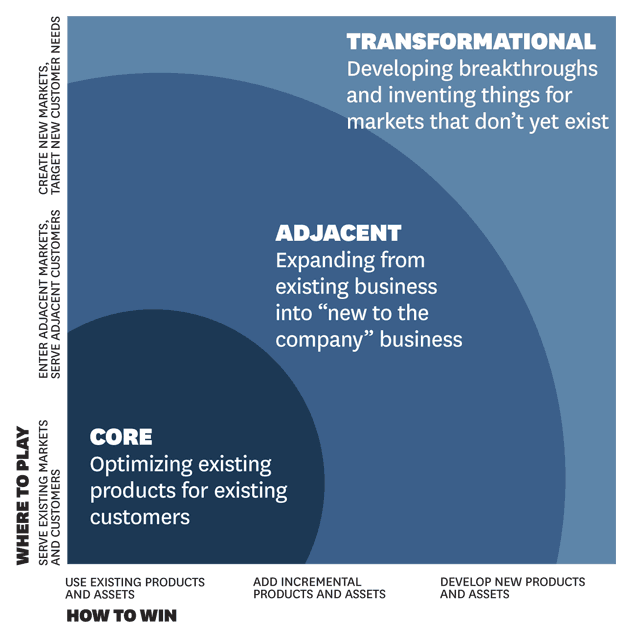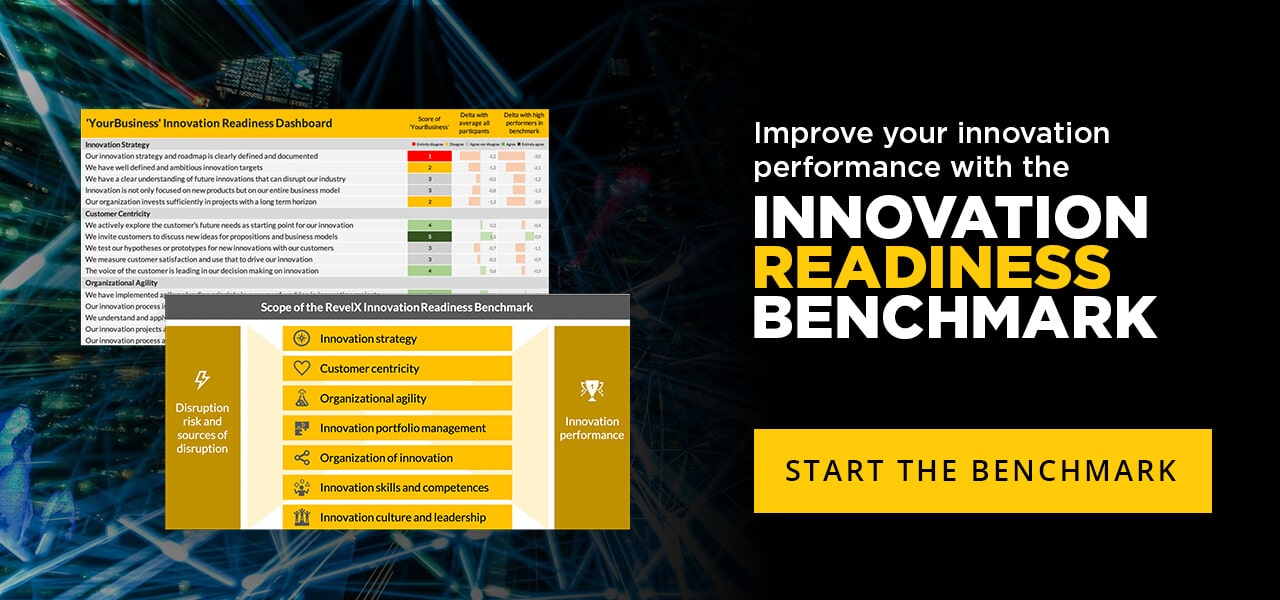Welcome to our third and final article in the series ‘Creative tools to provoke creative ideas’! In the first article we discussed the importance of connections for innovation. We looked at different types of connections to spur innovation, and evaluated how to create viable innovations using the ‘Ten Types of Innovation’ tool.
In our second article, we introduced the importance of ‘fresh perspectives’, and discussed the ‘Four Lenses of Innovation’, such as emerging trends and unmet needs.
In this third and final article we will take a look at the ‘Innovation Ambition Matrix’. But before that, let me ask you something: Have you ever been in a situation where someone asked the following: “any ideas”? As innocent as this question seems, many people find their mind going blank.
Hence, when running a brainstorm session, our experience is that many people wait for others to speak up first. Only in the last part of the session, idea production hits off. This is due to the fact that the more ideas (triggers) people see or hear, the more ideas they are able to come up with. It tends to look a bit like this:

For ideas to flow, we need to understand what triggers the people in the room. Research shows us that there are three learning modes that help stimulate the production of ideas.
- The first mode is visual stimulation. Changing the scene, seeing colours & pictures helps us make connections; it activates our imagination. Instead of starting your brainstorm session with an empty white-bord, try preparing a ‘mood board’, or post images, news articles et cetera on the wall.
- For some of us visual stimulation doesn’t quite do it, noise and conversation is their key to produce ideas. It is very likely they need a pre-amble conversation to kick-start their creativity.
- The third and final mode, is perhaps the most unknown. For the kinesthetic learners among us, doing something with their hands helps unlock creativity. It could be as simple as playing with a toy, or clicking a pen. They need to touch and feel things, and be given the chance to throw things around in their mind to make sure it feels right.
While reading the above, you might have recognized which mode most closely matches yours. As a brainstorm facilitator, the above modes are important as you will have different learners in your brainstorm session. You may use color, movement, interaction, conversation and combine all the modalities together to ensure everybody in the room is engaged and triggered.
Now that we have learned how kick-start idea production, it is important to ensure we have a clear model that helps us structure ideas. Hence, we introduce the innovation ambition matrix.
Model 3: Innovation Ambition Matrix
The innovation ambition matrix, as featured in the Harvard Business Review (May 2012), is a classic model that helps companies decide how to fund different growth initiatives. It identifies three different layers of innovation, from incremental to disruptive.

The first layer, ‘core’ focuses on very incremental innovations improving the existing product / service portfolio. You may think of new packaging, new product design, etc.
A little more adventurous are the ideas that we identify as ‘adjacent innovations’. This is where a company enters a new market with something they already do well. Think of modifying an existing product and selling it among a new customer segment. This stretches the companies’ current resources and abilities to serve customers in a whole different way
On the far end of the spectrum lie the ‘transformational initiatives’, the true game changers. This is where a company looks for a whole new market to serve new customer needs. For these ideas to flourish, companies need to be willing to invest in building new assets and develop new markets. If done successfully this can bring them a whole new business. You may think of Amazon’s Cloud Computing.
For the right balance between innovation initiatives, we advice you to follow the 70-20-10 rule. Research (HBR, May 2012) has shown that companies who allocate 70% of their activities on core, 20% on adjacent and 10% on transformational, outperform their peers.

Conclusion
The three modes of learning combined with the innovation ambition matrix can help you facilitate a productive workshop on defining your company its innovation ambition and activity. As in each workshop, the quality of the initiatives and the discussion around your company its specific ambition is crucial (and in our experience very inspiring and fun).
Although the above may sound obvious, few organisations think about the best level of innovation to target, and even fewer manage to achieve it. It is essential that your innovation portfolio serves the tactical need to innovate and improve, as well as the strategic imperative to continually strive for transformation.
Matthijs Rosman
Trusted and creative advisor. Specialist in growth acceleration and innovation. Combines analysis and creativity to develop surprising combinations. From new digital possibilities to ways to improve commercial results. Cordial towards others, sharp on details. Continuously looking for growth opportunities.
Related posts
Step 1. Why every CEO should play the DisruptR game with their team
DisruptR Game for CEOs fosters strategic innovation. Learn…
June 22, 2025
Innovation governance: Why every CEO needs a Growth Board
Growth Board for CEOs is essential. Discover how this…
June 19, 2025
Why innovation belongs on the CEO agenda
Innovation on the CEO agenda is essential. Explore why…
June 16, 2025




